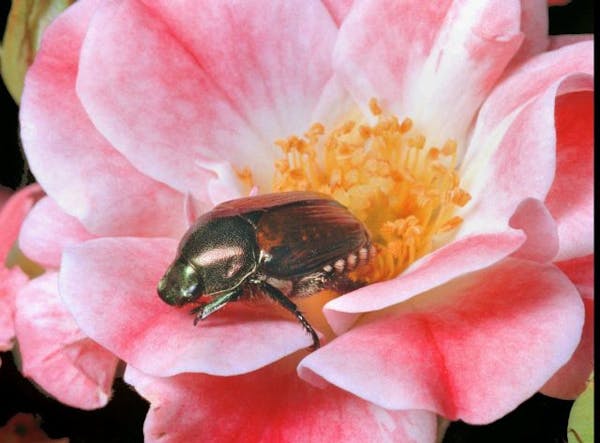The offer seemed too good to be true.
In a news announcement in June, the University of Minnesota Extension said it had a research team willing to come to Minnesotans' homes, dig up the Japanese beetle larvae infesting their lawns and replant grass.
But, as happens often enough, by the time this news reached the media, it was too late. The researchers had also made their offer to Minnesota's top gardeners and more than 200 offered their plots for the research, far more than the researchers needed.
Turns out that Japanese beetles aren't just a scourge for homeowners who want nice lawns.
"This is a huge problem because the beetles eat grapes and elderberries, distort the fruit, cause them to rot and reduce the food for wildlife," said Vera Krischik, an entomologist at the U who is one of the leaders on the research. "So it really reduces food for wildlife, not just for people."
Their literally grubby research shows the importance of basic science and the years of work that often take place before a breakthrough creates a business opportunity. In this case, the prospect is an organic product for reducing the number of Japanese beetles, which have been considered invasive since they arrived in Minnesota in the late 1960s.
They started to become a big problem about 20 years ago, though their populations go up and down.
Over the past few years, I've noticed one way to loosen up a group of strangers in the Twin Cities is to complain about the damage your lawn has seen from grubs, the larva-stage beetles that chew grass roots. Every homeowner seems to have their tale of woe.
The damage they cause is amplified by insect-feeding animals, like crows and raccoons, that go after them. After I mentioned the U's research at a recent dinner gathering, the host and other neighborhood guests told me about a family of wild turkeys that marched through their yards this spring, wrecking lawns as they fed on grubs.
The U's scientists for the past two summers have been trying to trap the beetles as part of an effort to establish a native soil pathogen that will kill them.
For now, Minnesotans must chiefly rely on insecticides to get rid of the beetles and their grubs. Some of those products, however, will kill bees and butterflies. (One exception, Krischik noted, is Scotts GrubEx.)
To take a natural approach, the U's scientists are looking at a pathogen called Ovavesicula common in Connecticut and other eastern states.
"In the East, this pathogen has been circulating for a long time and when the Japanese beetle arrived in 1917, it was present in the soil," Krischik said. "The good question is 'Why do our eastern [U.S.] soils have more of these spores of the pathogen than our Midwest soils?' If we can correlate what's good soil, then we can predict where to release this pathogen to make it go faster."
One of the countervailing forces the researchers face is that Japanese beetles love a pretty, healthy lawn as much as people do. They're attracted to blue-green grass and water. And they march on as people beautify their lawns.
"If you water your lawn and fertilize it, you're more susceptible," she said. "The trick would be to stop watering and let it go dormant when the females are out laying eggs."
Another challenge is that many people don't want to use insecticides because they're worried about harming other insects. They instead turn to organic solutions that aren't effective. The federal government several years ago ordered the removal of a bacteria that had been working in some of the organic offerings, Krischik said.
Researchers at Michigan State found that it takes about six years for the beetles to spread the pathogen, like a sickness, enough to reduce their population by about 30%.
In an update to their funders, the U researchers last week reported they're working at 30 sites around the state to determine the best way to introduce the pathogen to the grubs — directly on soil or via traps where they'll catch them and then release them to spread it around.
In a few years, they'll know whether they have been able to accelerate the spread of the pathogen in Minnesota. And that may create a commercial opportunity.
"I could see how you infect compost with the spores and people would buy the infected compost," Krischik said. "Down the line, some bright entrepreneur may be able to take the research and apply it."
Ramstad: This could be the week the NCAA becomes a professional league
Ramstad: Effort to change the ban on noncompetes emerges in the Legislature
Ramstad: What does 'Made in the USA' mean? Minnesota businesses like Nordic Ware are questioned.

Ramstad: Economic growth is becoming harder to achieve, but the U.S. has been managing it


